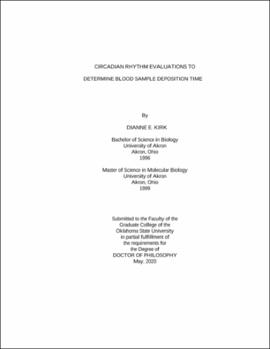| dc.contributor.advisor | Allen, Robert W. | |
| dc.contributor.author | Kirk, Dianne E. | |
| dc.date.accessioned | 2020-09-09T21:16:23Z | |
| dc.date.available | 2020-09-09T21:16:23Z | |
| dc.date.issued | 2020-05 | |
| dc.identifier.uri | https://hdl.handle.net/11244/325481 | |
| dc.description.abstract | The use and applications of DNA and RNA analysis has become an invaluable forensic tool in criminal investigations. Recent research from this laboratory applied quantitative analysis of RNA as a means of estimating the age of crime scene samples. Linking the age of an evidentiary sample to the time a crime was committed can strengthen the prosecution of a perpetrator. | |
| dc.description.abstract | Organisms exhibit a circadian rhythm that is observed as 24-hour cyclic processes that can be detected through oscillating quantities of mRNA and protein. It has been estimated that ten percent of the human transcriptome demonstrates rhythmic expression patterns of mRNA. Thus, an opportunity exists to harness a natural biologic process through quantitative RNA analysis to perhaps refine our ability to estimate when a crime scene sample was created. | |
| dc.description.abstract | The aim of this current study was to determine if it is feasible to identify when, during a 24-hour day, a blood stain was created at a crime scene. In order to establish a reference pattern of gene expression that reflects a 24-hour day, it was necessary to assess the stability of the mRNA transcripts from cycling genes in dried stains as well as to explore the variability in the expression of these genes among members of the population. Results demonstrated that all transcripts studied were stable for the short period between production of a blood stain and the extraction and reverse transcription of RNA recovered from a stain. In addition, mRNA expression levels were compared between groups of blood donors of different age and also between the sexes. Evaluations of transcript levels were also performed to validate naturally occurring fluctuations in gene expression. Finally, blood stains collected every 4 hours for 24 hours were assessed using qPCR, for mRNA expression levels in order to identify genes exhibiting rhythmic patterns that could be referenced for time determination. | |
| dc.description.abstract | Overall, results from the current study validate the feasibility of using gene expression during the circadian rhythm to further refine our ability to determine when, during a 24-hour day, a blood stain was created at a crime scene. | |
| dc.format | application/pdf | |
| dc.language | en_US | |
| dc.rights | Copyright is held by the author who has granted the Oklahoma State University Library the non-exclusive right to share this material in its institutional repository. Contact Digital Library Services at lib-dls@okstate.edu or 405-744-9161 for the permission policy on the use, reproduction or distribution of this material. | |
| dc.title | Circadian rhythm evaluations to determine blood sample deposition time | |
| dc.contributor.committeeMember | Wilson, Nedra | |
| dc.contributor.committeeMember | Koehler, Gerwald | |
| dc.contributor.committeeMember | Champlin, Franklin | |
| dc.contributor.committeeMember | Miller, Bavette | |
| osu.filename | Kirk_okstate_0664D_16722.pdf | |
| osu.accesstype | Open Access | |
| dc.type.genre | Dissertation | |
| dc.type.material | Text | |
| dc.subject.keywords | circadian rhythm | |
| dc.subject.keywords | clock genes | |
| dc.subject.keywords | forensic science | |
| dc.subject.keywords | methylation | |
| dc.subject.keywords | mrna | |
| dc.subject.keywords | peripheral blood | |
| thesis.degree.discipline | Biomedical Sciences | |
| thesis.degree.grantor | Oklahoma State University | |
